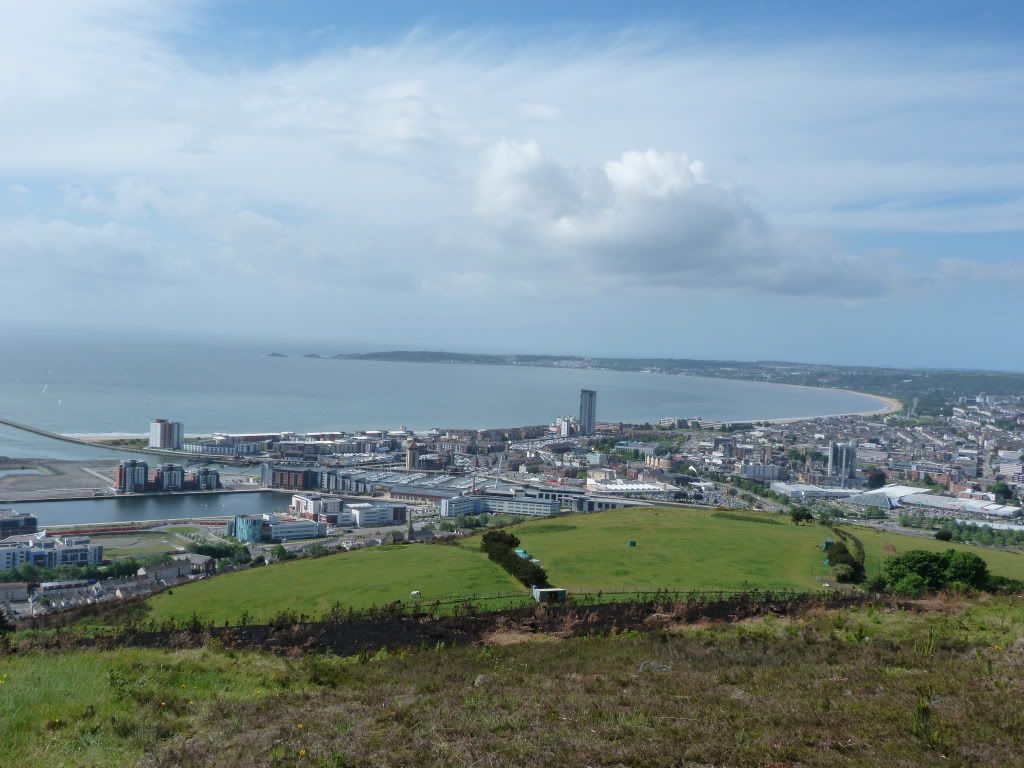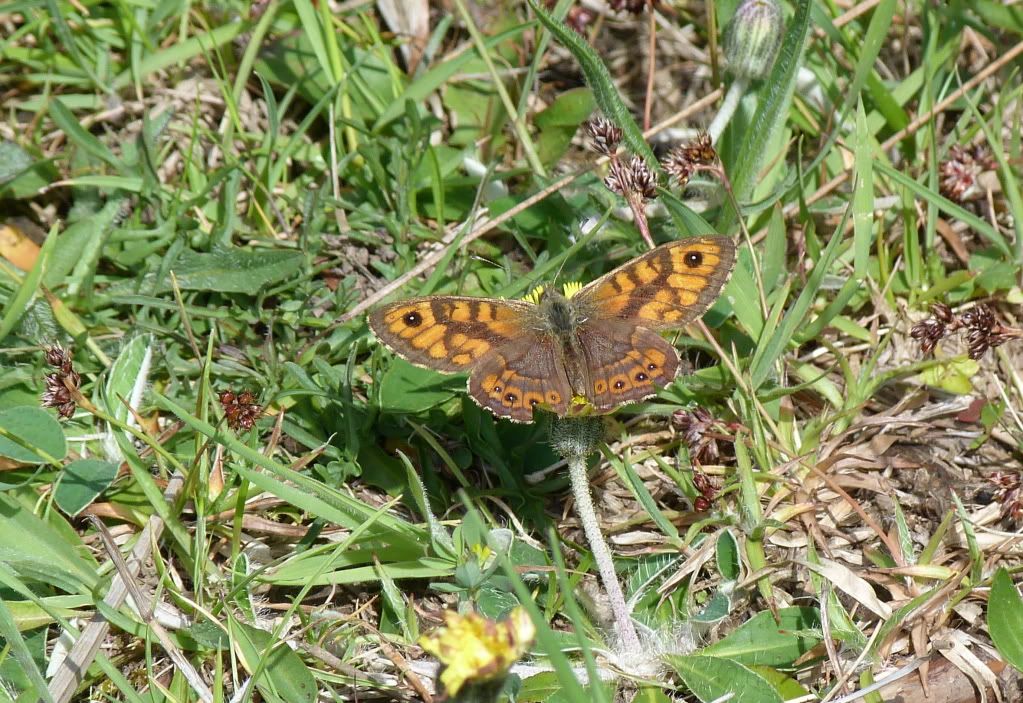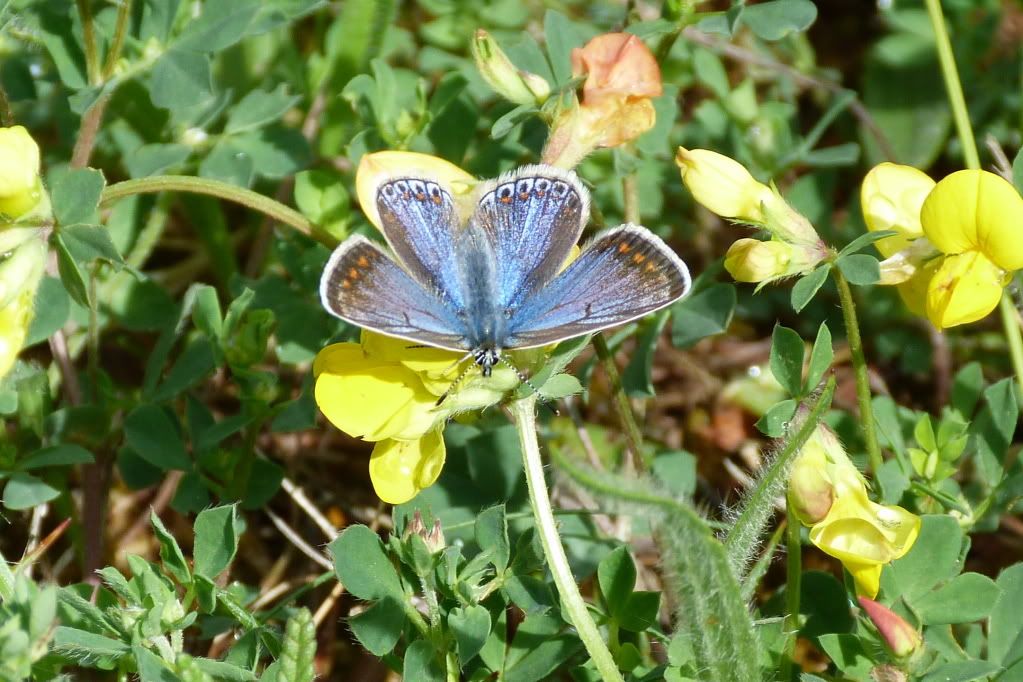Page 2 of 12
Re: May 2011
Posted: Tue May 03, 2011 5:53 am
by Jack Harrison
Sandra and Kevin.
What extraordinarily good photos.
I am also amazed that a site so far north (Sywell Wood) should have Wood Whites flying this early. Normally they are later to emerge than those in the south. But this is a quite amazing season; but I am ceasing to be amazed.
Sure the Surrey Wood Whites in recent years have been almost invariably double brooded but the Northants butterflies are usually thought to be strictly single brooded (I stand to be corrected). So what will happen in Northants this year I wonder?
Jack
Re: May 2011
Posted: Tue May 03, 2011 11:48 am
by FISHiEE
I also couldn't resist another couple of trips back for the Wood Whites near Plaistow, if anything just to get somewhere out of the wind!
I explored much more of the woodlands this time and found them quite plentiful through most of the areas I walked. Saw 3 Downy Emerald Dragonflies as well yesterday, which I've only ever seen once before, so that was a vern nice bonus!
Re: May 2011
Posted: Tue May 03, 2011 3:19 pm
by Susie
Incomers!
Just got home to find a painted lady in the garden.

There was a red admiral on Sunday which looked a bit "foreign" too.
I went up to Heyshott Down today. Good numbers of Dukes, green hairstreak, dingy skipper, brimstone, orange tip, speckled wood, a couple of very fresh small heath and an extremely tatty small tortoiseshell.
Re: May 2011
Posted: Tue May 03, 2011 9:13 pm
by Ian Pratt
Pauline wrote:Hi Guys
Thought you might like to know that despite cool, windy conditions there were about a dozen Glanville Fritillaries at Wheelers Bay today.
Great photo! I was there with my wife yesterday and it was blowing a gale. Still over 20 GFs in good condition. some were blown in to the sea sadly!

Re: May 2011
Posted: Tue May 03, 2011 9:23 pm
by Willrow
Some very nice images David, I personally think the underwings are more attractive than the uppers, the shot you've shown above illustrates this perfectly for me.
Some lovely walks throughout the Common during most seasons, but the PBF season has to be my favourite, lots of superb Bugle and Bluebells to savour. Superb views from the top, with the Black Mountains and Golden Valley either side. It can prove a little confusing though, it's pretty big, and can take a few visits before you get your bearings (as you've also mentioned previously). There are some very nice wildflower meadows outside the main common area that are a delight to explore when in full bloom too, never know what may be passing through. The Autumn provides an excellent show of Meadow Saffron
Colchicum autumnale too, if my memory serves, it's a simply lovely place.
Bill

Re: May 2011
Posted: Wed May 04, 2011 6:32 am
by Zonda
Another pocket of Dukes found at Cerne Abbas, Dorset. Six, maybe seven seen.

Re: May 2011
Posted: Wed May 04, 2011 2:37 pm
by Zonda
The eruption of Marsh Fritillaries at Cerne Abbas , Dorset this season, has been a spectacle to behold. I sort of guessed it was going to be a fantastic season for these at Cerne, aided by the observation of huge numbers of caterpillars quite early on. Nor is it over yet, as it was difficult to avoid treading on them on the hillside sheep tracks yesterday. A bumper year.

Re: May 2011
Posted: Wed May 04, 2011 3:18 pm
by celery
Re: May 2011
Posted: Wed May 04, 2011 9:04 pm
by Gibster
Finally managed to combine a day off with the good weather, so shot off to Dungeness in Kent. Surprisingly cold in the easterly winds, but the sheltered spots provided my first Brown Argus (2), Common Blue (1) and Small Coppers (10) of the year. Two of the latter were caeruleopunctata. At one point there were three individuals nectaring on the same hawthorn blossoms and allowing a very close approach, lovely! Also lots of Pale Grass Eggar caterpillars roaming the shingle and a probable (but very brief) Vagrant Emperor on the RSPB reserve.
Gibster.
Re: May 2011
Posted: Thu May 05, 2011 10:23 am
by A_T
Fenn's and Whixall Moss yesterday. Had hoped for Pearl BFs but out of luck don't think there have been any there for a long time.
Quite a few Green Hairstreaks, Peacocks, Small Coppers. Also managed to catch a Mrs Brimstone laying.
Re: May 2011
Posted: Thu May 05, 2011 8:14 pm
by admiral halsey
As a newbie to this hobby, I was thrilled to see my first grizzled Skipper two days ago at langdon Hills, Basildon (been on a Resuscitation Course wed/thurs, hence delay in posting here), also four female Orange tips and a male, plus three Speckled wood.
Rich
Re: May 2011
Posted: Thu May 05, 2011 9:37 pm
by Gibster
Started the day hunting roosting Small Blues in Surrey at 8:30am (very cold and a bit drizzly) but managed one, hunkered down low in herbage. Then, after a mad text message, I was off chasing an Ortolan Bunting in Richmond Park (missed it...grrrr!) later followed by damselfly spotting near Ripley (3 species). At midday it began to finally warm up! Then on to Newlands Corner accessed from White Lane end. Plenty of Brimstones, I noticed the females in particular indulging in a lot of nectaring, plus my first Small Heaths of the spring, often 2 or 3 spiraling away in tight circles. Brown Argus, Common Blue, Speckled Wood, Grizzled and Dingy Skippers, Orange-tip and my first Large White of the year. Also Mother Shiptons here and a burnet larva preparing to pupate halfway up a grass stem. Then dashed back to pick Sam up from her workplace, returned to a now gloriously sunny Small Blue quarry (we saw 3) plus Green-veined and Small Whites bringing the day total to 13 species. Sweet

Gibster.
Re: May 2011
Posted: Thu May 05, 2011 9:42 pm
by Ian Pratt
The Isle of Wight is wonderful in many ways not least because of the flora and fauna eg Glanville fritillaries, red squirrels and the reddish buff moth. However, at the moment apart from GFs which are very good, the orange tips are spectacular. Today I found a place where they actually stopped so I could photograph them, settling on various flowers and plants. I also manged to get a good length of video of one. I will try to upload it to Youtube.

Re: May 2011
Posted: Sat May 07, 2011 7:04 pm
by millerd
Creature of habit that I am, I went to Denbies for the afternoon. There was intermittent weak sunshine (good), but a strongish breeze (not so good). However, the hillside was alive with little blue jewels. I have never seen so many Adonis Blues: mostly brilliant males, but plenty of females too. There were Dingy and Grizzled Skippers in good numbers, plus Green Hairstreaks and Small Heaths, but the Adonis stole it.
With so many to look at, I concentrated on those that seemed a bit different. I found three in particular that seemed to lack a bit of underside spotting, similar to the aberrant Chalkhill Blues I saw at the same site last year. All were characterised by being much smaller than usual, being a darker shade of blue, and having some deformity of the wings. Some shots below of two of the butterflies.
Dave
Re: May 2011
Posted: Sat May 07, 2011 10:48 pm
by Matthebirder
Haugh Woods : Pearl-bordered Fritillaries (and Wood Whites)
Thank you to Jack Harrison and others for the detailed site desciptions ; very useful today in terrible conditions but my first chance at this species having undertaken the 300 mile round trip from Cambs. For anyone visiting from the east where a long trip is necessary, PBF's were in the carpark at mid afternoon, though the area descibed by Jack is well worth the 20 min walk as quite a few present, though many have seen better days now. Wood Whites common along the main track to the right at the first main fork just south of the carpark though also seen at the carpark while we were drying out! A good site all round but be careful of the Carrion Crow in the carpark, it has badly scratched the paintwork of my 'new' car all round the panels by jumping up presumably attacking its own reflection. Its a black car so that might also account for its frustrated behaviour; maybe non-black cars are fine! (Also some nice Greater Butterfly Orchids if anyone is keen on orchids too).
Matthew
Re: May 2011
Posted: Sun May 08, 2011 2:40 pm
by admiral halsey
Just returned from a lovely walk in Langdon Hills. Luckily at the end of my walk I saw this obliging Grizzled Skipper who posed for about a minute before deciding to move on. Also saw a speckled wood, three male Orange tips and about ten females.
Rich
Re: May 2011
Posted: Sun May 08, 2011 3:30 pm
by Pauline
I made my first ever trip to Denbies today to see the blue jewles that Dave described and despite the gale which almost blew me away at times I was not disappointed. However, I was concerned at the number of deformed Adonis, all males. I must have seen 6 or 7 and I am sure they weren't the same individuals as the degree of deformity differed. Has anyone any ideas what could be causing this (genetic? climate?) and it it happening at any other sites?
Pauline
Re: May 2011
Posted: Sun May 08, 2011 3:31 pm
by admiral halsey
This (I think female) Holly Blue was sitting on my Forsythia bush for some time this afternoon, enabling a number of shots with both my point and shoot and my daughter's Fuji S1800.
Rich
Re: May 2011
Posted: Sun May 08, 2011 4:46 pm
by Susie
Pauline wrote:I made my first ever trip to Denbies today to see the blue jewles that Dave described and despite the gale which almost blew me away at times I was not disappointed. However, I was concerned at the number of deformed Adonis, all males. I must have seen 6 or 7 and I am sure they weren't the same individuals as the degree of deformity differed. Has anyone any ideas what could be causing this (genetic? climate?) and it it happening at any other sites?
Pauline
Hi Pauline,
As I mentioned earlier in the week and Dave mentioned above there seemed to be a great many blues with crippled wings. I put it down to the dry conditions as I know emerging butterflies can have trouble exiting extremely dry cases but it could be genetic I suppose.
Re: May 2011
Posted: Sun May 08, 2011 5:12 pm
by David M
It's not really butterfly weather in Swansea right now, but after a week without venturing outdoors, I thought I'd go and climb Kilvey Hill on the seafront this morning before the rain came (and it duly did at about 1300hrs).
Apart from Common Blues, there were very few butterflies about. Orange Tips have vanished and even Green Veined Whites are numbering single figures.
I was pleased to see a male Wall Brown at the top of the hill as well as a solitary Small Blue lower down. No Green Hairstreaks were spotted though, and much of the gorse has burned to a cinder due to the recent fires that have beset the hillsides around here.

Blustery up there at 1100 this morning, but lovely views of the bay and the Gower in the distance

Solitary male Wall near the top of the hill

I particularly like the very blue females






